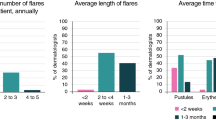Abstract
Background
Current understanding of the etiology, natural history, and outcomes of acute generalized exanthematous pustulosis (AGEP) has been limited, with most available studies consisting of small or heterogenous cohorts.
Objectives
The aim of this study was to further characterize associated factors and disease outcomes of AGEP.
Methods
A cross-sectional study design was employed with formal inclusion and causality criteria. Patients were identified from an inpatient database at an academic medical center, including 65 patients with AGEP and a control group of 61 patients with non-severe cutaneous adverse reactions.
Results
Increased age and body mass index (BMI) were associated with higher risk of AGEP (p < 0.001). Length of stay was longer for both the overall AGEP cohort (13.1 days) and a subcohort with a primary discharge diagnosis of AGEP (9.7 days) compared with the control group (3.6 days) [p < 0.001]. Patients with AGEP were more likely to be discharged to a long-term care facility compared with control patients (p < 0.001).
Conclusions
AGEP was associated with longer length of hospitalization, higher rates of discharge to long-term care facilities, and higher mortality compared with non-severe cutaneous adverse drug reaction (SCAR) medication reactions. Future research should examine the association between morbid obesity and this particular drug reaction, and the possibility of decreasing hospitalization length given the relatively low risk of mortality among patients with AGEP.
Similar content being viewed by others
References
Sidoroff A, Halevy S, Bavinck JNB, et al. Acute generalized exanthematous pustulosis (AGEP)—a clinical reaction pattern. J Cutan Pathol. 2001;28:113–9.
Szatkowski J, Schwartz RA. Acute generalized exanthematous pustulosis (AGEP): a review and update. J Am Acad Dermatol. 2015;73:843–8.
Oh DAQ, Yeo YW, Choo KJL, et al. Acute generalized exanthematous pustulosis: Epidemiology, clinical course, and treatment outcomes of patients treated in an Asian academic medical center. JAAD Int. 2021;3:1–6.
Sidoroff A, Dunant A, Viboud C, et al. Risk factors for acute generalized exanthematous pustulosis (AGEP)—results of a multinational case-control study (EuroSCAR). Br J Dermatol. 2007;157:989–96.
Thienvibul C, Vachiramon V, Chanprapaph K. Five-year retrospective review of acute generalized exanthematous pustulosis. Dermatol Res Pract. 2015;2015: 260928.
Bhat YJ, Akhtar S, Ahmad M, et al. Etiopathological and clinical study of acute generalized exanthematous pustulosis: experience from a tertiary care hospital in North India. Indian Dermatol Online J. 2020;11:391.
Loo C, Tan W, Khor Y, et al. A 10-year retrospective study on severe cutaneous adverse reactions (SCARs) in a tertiary hospital in Penang Malaysia. Med J Malaysia. 2018;73:73–7.
Hadavand MA, Kaffenberger B, Cartron AM, et al. Clinical presentation and management of atypical and recalcitrant acute generalized exanthematous pustulosis (AGEP). J Am Acad Dermatol. 2020;87(3):632–9.
Naranjo CA, Busto U, Sellers EM, et al. A method for estimating the probability of adverse drug reactions. Clin Pharmacol Ther. 1981;30:239–45.
Goldenberg M, Amigo M, Krishna S, et al. Validation of generalized drug-related rash diagnoses using International Classification of Diseases 9th and 10th revision codes. Br J Dermatol. 2022;186(3):583–5.
Yoshikawa TT, Norman DC. Geriatric infectious diseases: current concepts on diagnosis and management. J Am Geriatr Soc. 2017;65:631–41.
Crossley KB, Peterson PK. Infections in the elderly. Clin Infect Dis. 1996;22(2):209–15.
Zarb P, Amadeo B, Muller A, et al. Antimicrobial prescribing in hospitalized adults stratified by age. Drugs Aging. 2012;29:53–62.
Pea F. Pharmacokinetics and drug metabolism of antibiotics in the elderly. Expert Opin Drug Metab Toxicol. 2018;14:1087–100.
Cojutti P, Arnoldo L, Cattani G, et al. Polytherapy and the risk of potentially inappropriate prescriptions (PIPs) among elderly and very elderly patients in three different settings (hospital, community, long-term care facilities) of the Friuli Venezia Giulia region, Italy: are the very elderly at higher risk of PIPs? Pharmacoepidemiol Drug Saf. 2016;25:1070–8.
Modesto ACF, Silveira EA, Rodrigues APDS, et al. Prevalence of adverse drug events in severely obese adults and associated factors: clinical trial baseline results. Sci Pharm. 2020;88:41.
Lumeng CN, Saltiel AR. Inflammatory links between obesity and metabolic disease. J Clin Investig. 2011;121:2111–7.
Bremmer S, Van Voorhees AS, Hsu S, et al. Obesity and psoriasis: from the Medical Board of the National Psoriasis Foundation. J Am Acad Dermatol. 2010;63:1058–69.
Yosipovitch G, DeVore A, Dawn A. Obesity and the skin: skin physiology and skin manifestations of obesity. J Am Acad Dermatol. 2007;56:901–16.
Author information
Authors and Affiliations
Corresponding author
Ethics declarations
Funding
BHK was supported by funding from the Dermatology Foundation.
Conflict of interest
Benjamin H. Kaffenberger was supported by the Dermatology Foundation. Kelsey B. Nusbaum, Trent D. Walker, Sonia Himed, John Christopher Trinidad, Natalie Spaccarelli, and Catherine Chung have no conflicts of interest to report.
Author contributions
All authors contributed to the study conception and design. Material preparation, data collection, and analysis were performed by KBN, TDW, SH and BHK. The first draft of the manuscript was written by KBN and all authors commented on previous versions of the manuscript. All authors read and approved the final manuscript.
Ethics approval
Not applicable.
Consent to participate/publish
Not applicable.
Code availability
Not applicable.
Data availability statement
Data used for this project contain patient health information and thus cannot be made available for public use.
Rights and permissions
Springer Nature or its licensor (e.g. a society or other partner) holds exclusive rights to this article under a publishing agreement with the author(s) or other rightsholder(s); author self-archiving of the accepted manuscript version of this article is solely governed by the terms of such publishing agreement and applicable law.
About this article
Cite this article
Nusbaum, K.B., Walker, T.D., Himed, S. et al. Patient Care Outcomes in Hospitalized Patients with Acute Generalized Exanthematous Pustulosis: A Cross-Sectional Database Study. Am J Clin Dermatol 24, 299–304 (2023). https://doi.org/10.1007/s40257-022-00737-5
Accepted:
Published:
Issue Date:
DOI: https://doi.org/10.1007/s40257-022-00737-5




